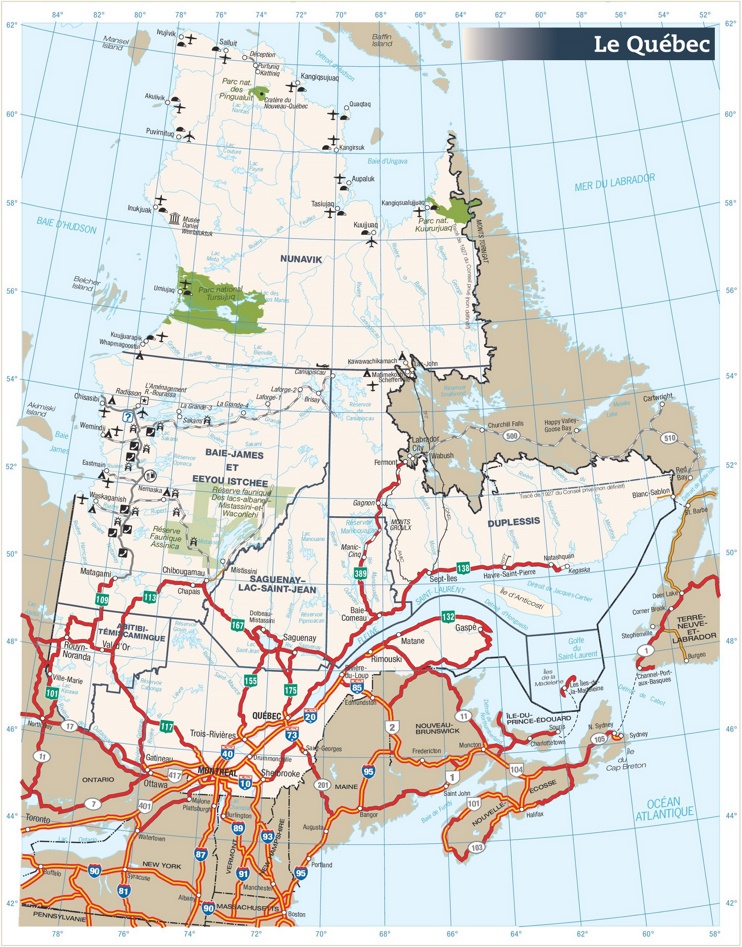Quebec Road Map
Description:
This map shows cities, towns, highways, main roads, secondary roads, rivers, lakes, railways, airports, and national parks in Quebec.
Size: 2047x2612px / 1.82 Mb
Quebec's Road Network: Facts and Challenges
Quebec's road network is a vital component of the province's infrastructure, spanning approximately 325,000 kilometers across its vast territory. The Ministry of Transport and Sustainable Mobility (MTMD) manages about 31,000 kilometers of highways, national routes, regional roads, and collector roads, along with nearly 11,000 structures including bridges and tunnels. Municipalities maintain 107,000 kilometers of local roads, while the Ministry of Forests, Wildlife and Parks oversees approximately 186,000 kilometers of access roads to resource territories. The replacement value of road infrastructure under the Ministry's responsibility is estimated at over 30 billion dollars.
The province faces unique challenges in maintaining its road network. Quebec's extreme climate conditions make it one of the most difficult places in the world to maintain and operate roads. Temperature variations can reach 25°C within hours, and for more than four months each year, the ground freezes to depths varying from 1.2 to 3 meters depending on the region. Annual precipitation averages 1,000 mm, including significant snowfall. During spring thaw periods, road surface resistance is reduced by approximately 40%, making the infrastructure particularly vulnerable to damage.
The Quebec highway system consists of 31 different routes with numbering based on function and orientation. Even-numbered highways generally run parallel to the St. Lawrence River (east-west), while odd-numbered highways run perpendicular to it (north-south). The speed limit is typically 100 km/h, reduced to 70-90 km/h in urban areas with heavy traffic. Highway maintenance is especially challenging due to the freeze-thaw cycles that accelerate pavement deterioration.
Climate Change Impacts and Adaptation
Climate change presents significant challenges for Quebec's road network. The province is warming at nearly twice the global average rate, with temperatures increasing almost two degrees Celsius since pre-industrial times. This warming accelerates infrastructure degradation through multiple mechanisms: increased frequency of freeze-thaw cycles in winter creates more potholes and cracks; extreme heat episodes cause softening and deformation of asphalt; and increased precipitation saturates drainage systems and weakens road foundations.
Coastal roads are particularly vulnerable to erosion and flooding, a situation exacerbated by the absence of protective winter ice. Winter storms batter more vulnerable shorelines, frequently threatening roads along the St. Lawrence River. Approximately two-thirds of climate change adaptation investments are directed toward coastal zones. In northern regions, thawing permafrost undermines the foundations of roads and other infrastructure built on previously stable frozen ground.
To address these challenges, the Ministry of Transport has implemented an adaptation action plan that covers all infrastructure. New design standards incorporate the latest climate data for roads, drainage systems, bridges, and culverts. Innovation in drainage methods, temperature-resistant materials, and reinforced shore protection is being prioritized to ensure the resilience of Quebec's vital road network in the face of ongoing climate change.
Traffic and Vehicle Statistics
According to data from the Société d'assurance automobile du Québec (SAAQ), the vehicle fleet exceeded six million vehicles in 2014, representing a 34% increase since 2000. Passenger vehicles increased by 23.4% between 2000 and 2014, reaching over 4.7 million, while heavy trucks grew by 25.7% to more than 135,000. The transportation sector accounts for approximately 43% of Quebec's greenhouse gas emissions, with road transportation alone responsible for 31.2% of total emissions. The province is actively promoting electric vehicle adoption, with goals to electrify 55% of urban buses and 65% of school buses by 2030.
Despite having one of North America's most extensive highway networks per capita, Quebec continues to experience increased traffic congestion. The Capitale-Nationale region alone has 481.3 km of highways, approximately 20 km per 100,000 residents, placing it first in Canada and third in North America for highway density. This extensive network, largely built in the 1960s and 1970s, now shows significant signs of aging, requiring substantial maintenance and renovation work to meet the needs of increasing traffic volumes and to withstand the impacts of climate change.
Maps of Quebec: Large detailed map of Quebec | Map of Quebec with cities and towns | Map of Southern Quebec
You may download, print or use the above map for educational, personal and non-commercial purposes. Attribution is required. For any website, blog, scientific research or e-book, you must place a hyperlink (to this page) with an attribution next to the image used.
Maps of Canada
Provinces and Territories
Cities of Canada
Cities of Canada

